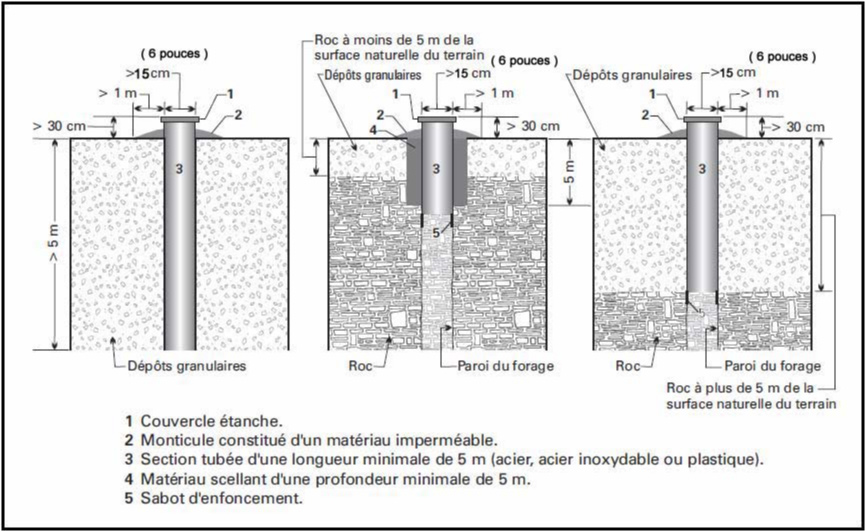How is an Artesian Well Constructed?
How is an Artesian Well Constructed?
Before the water reaches your faucet, groundwater must be extracted by the “catchment work” system, which comprises the following main components: casing, well cap, pump, connecting hoses and water tank. The choice of the proper “catchment work” system depends on the local hydrogeological context and your water requirements.
The artesian well
An artesian well, also known as a tube well, is one of the two most popular methods for groundwater catchment in Québec. Unlike the surface well, the advantage of the artesian water is that it extracts the water from greater depths, and therefore, farther from sources of contamination.
A tube well (see diagram) is a narrow-diameter catchment work system that usually consists of a deep hole (in excess of 9 m) that is dug using a drill, whereas a surface well is a shallower and wider diameter well that is dug using a backhoe.
The casings for an artesian well must be at least 5.3 m long, with and an interior diameter of more than 8 cm. The casing must be at least 30 cm from the surface of the ground.
Where does the water in the well come from?
Groundwater is water that is found beneath the surface of the ground and that fills the fractures in the bedrock or the pores in the granular mixture of sand and gravel. Unlike surface water, groundwater is not canalized, like a stream or a river, but circulates within the depths of the geological formations that comprise the underground area.
Rainwater seeps into the ground, circulates vertically down to the saturation zone (water table) and travels toward the natural discharge zone (watercourse) located downstream. This sequence can spread out over dozens of kilometres through the various geological formations, and during this journey the water is collected by the catchment work system, which enables it to pump the water required for a variety of needs.
Groundwater is not static. It remains in constant motion, and moves from a high point towards a low point through permeable soils (sand and gravel) or through the network of bedrock fractures. The majority of the groundwater used in Québec circulates within 100 meters below the surface of the ground.
Pumping the water
Once the well is drilled and the required volume of water is attained, the water must be pumped to your faucet. This is accomplished by installing a submersible pump at the bottom of the well. The wiring for the pump and the collector hoses extend beyond the well casing below ground level toward the building.
The installation techniques that we use at Dufresne-Laniel Water Well Drilling allow us to protect the water collector hoses against freezing, even in locations where the bedrock reaches ground level. The collector hose is then connected to a water tank, which ensures a stable pressure for your drinking water supply.
The water tank and the well itself provide a reservoir for your water supply. The deeper the well, the greater the water supply. In fact, the water supply increases the capacity of your well during periods of heavy consumption.
Source: Dufresne-Laniel Water Well Drilling and the Ministère du Développement durable, de l’Environnement et des Parcs du Québec.


